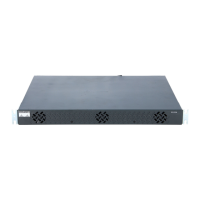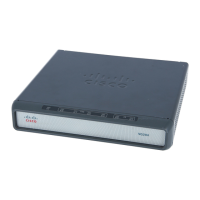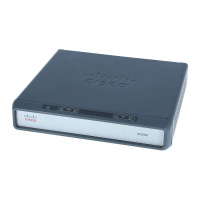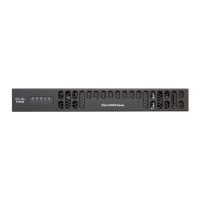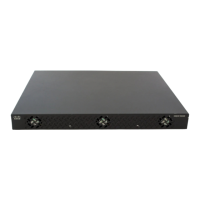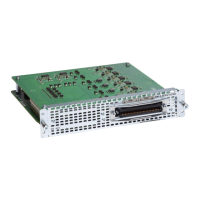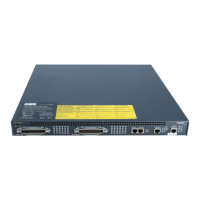
Do you have a question about the Cisco VG248 - Gateway and is the answer not in the manual?
| Device Type | Voice Gateway |
|---|---|
| Form Factor | Rack-mountable |
| Operating Temperature | 32°F to 104°F (0°C to 40°C) |
| Ports | 48 FXS ports |
| Protocols | SIP |
| Voice Codecs | G.711, G.729, G.726 |
| Network Interface | Ethernet 10/100/1000 |
| Mounting Options | Rack-mountable |
| Relative Humidity | 10% to 90% (non-condensing) |
| Compliance | FCC, CE, UL |
| Power Supply | AC 120/230 V (50/60 Hz) |
| Dimensions | 17.5 x 1.75 x 12.5 inches (44.45 x 4.45 x 31.75 cm) |
Provides an overview of the guide's purpose and scope for configuring the VG248.
Identifies the target audience for this configuration guide.
Outlines the goals and expected outcomes of using this guide.
Explains the structure and layout of the document.
Lists other relevant Cisco documentation for further information.
Provides sources and methods for acquiring Cisco documentation.
Details how to get support and help from Cisco.
Explains how the VG248 fits into the Cisco IP telephony infrastructure.
Details the telephony features supported by the VG248 device.
Lists the specific telephony features offered by the VG248.
Describes how message waiting indicators (MWI) are handled by the VG248.
Explains the different modes for controlling analog phone features.
Details the VG248's support for caller ID information.
Lists the types of analog devices that can be connected to the VG248.
Details the data, voice, and network management protocols supported by the VG248.
Describes methods to access the VG248's configuration interface.
Explains how to restart the VG248 device for configuration changes to take effect.
Details the essential network settings required for VG248 connectivity.
Covers the process of setting passwords to secure the VG248 device.
Outlines how to configure SNMP settings for remote network management.
Specifies how to identify the TFTP server for Cisco CallManager integration.
Explains how to modify the device name used for VG248 registration.
Details how to disable the Cisco Fax Relay feature on the VG248.
Describes how to revert the VG248 to its previous configuration settings.
Guides on selecting the appropriate call control mode for analog phone features.
Explains how to configure feature codes for accessing telephony functions.
Details setting the country code to configure country-specific telephony parameters.
Describes how to adjust the hook flash timer for analog phones.
Explains how to configure the policy for enabling VG248 ports for registration.
Covers the configuration of various parameters on a per-port basis for analog devices.
Details how to enable a specific port for registration with Cisco CallManager.
Details how to enable caller ID on a per-port basis for analog devices.
Explains how to select the type of MWI notification for analog phones.
Describes how to enable disconnect supervision for analog devices.
Covers adjusting the output gain for analog phone signals.
Details how to modify the input gain for analog phone signals.
Provides an overview of how Cisco CallManager handles VG248 ports as individual devices.
Details the process of adding the VG248 to the Cisco CallManager system.
Describes the automatic process of registering VG248 ports with Cisco CallManager.
Explains the manual steps to add VG248 ports to Cisco CallManager.
Explains how to configure the individual analog ports of the VG248 within CallManager.
Introduces SMDI and its role in integrating voice mail systems with Cisco CallManager.
Guides on selecting the appropriate SMDI integration method for voice mail.
Details the basic SMDI integration setup for voice mail systems.
Explains how to chain multiple VG248 devices for expanded voice mail integration.
Describes integrating SMDI with multiple CallManager clusters or PBX systems.
Outlines the necessary changes in CallManager to support SMDI ports.
Covers updating service parameters in CallManager for SMDI voice mail.
Details adding a dedicated port for MWI functionality in CallManager.
Explains how to add and configure VG248 ports for voice mail in CallManager.
Describes modifying end-user phone settings for SMDI voice mail access.
Covers local SMDI configuration settings on the VG248 device.
Explains how to identify the pilot directory number for voice mail access.
Details how to assign the number of ports for SMDI functionality.
Guides on identifying the first port connected to the voice mail system.
Covers setting the number length for SMDI communication.
Explains the option to truncate SMDI numbers if they are too long.
Details how to configure the SMDI number format for compatibility.
Specifies whether the VG248 forwards MWI commands to Cisco CallManager.
Describes forwarding MWI commands to the next device in the SMDI chain.
Explains how to forward INV responses to Async 1 for error handling.
Details identifying the DN for setting MWI in CallManager.
Explains identifying the DN for clearing MWI in CallManager.
Covers setting a keep alive number for SMDI connection monitoring.
Details configuring disconnect notification for SMDI connections.
Provides methods for verifying and troubleshooting SMDI connections.
Guides on checking the status of Async 1 and Async 2 connections.
Explains how to view port status and traffic statistics for SMDI links.
Covers evaluating SMDI configuration and diagnosing issues.
Details how to temporarily suspend SMDI port activity for maintenance.
Details how to resolve SMDI-specific errors and warnings.
Covers identifying and resolving hardware-related issues on the VG248.
Guides on how to display the VG248's hardware status and environmental information.
Details how to identify issues related to the VG248's fans.
Explains how to identify problems with the VG248's power supplies.
Covers monitoring the internal operating temperature of the VG248.
Addresses issues related to exceeding the VG248's phone connection limits.
Provides guidance on resolving other miscellaneous hardware errors.
Details how to identify and resolve software-related problems on the VG248.
Guides on resolving network and system-related errors on the VG248.
Details how to resolve errors related to analog phones and features.
Explains how to resolve communication issues with Cisco CallManager.
Explains the process of upgrading the VG248's software images.
Describes the procedure for upgrading the VG248's main software image.
Explains how to upgrade the VG248's boot loader image, with caution.
Provides steps to resolve issues from interrupted software upgrades.
Guides on how to verify the VG248's network connectivity.
Describes how to view current status and configuration details of the VG248.
Guides on viewing the VG248's system status, including network settings.
Explains how to observe network traffic and packet errors.
Details how to view the status of individual ports on the VG248.
Provides in-depth status information for each port.
Shows statistics for current calls on individual ports.
Allows viewing all configured settings on the VG248.
Shows the current software version installed on the VG248.
Explains how to monitor VG248 status remotely using a web browser.
Covers using the event log for capturing and analyzing VG248 messages.
Covers identifying and configuring a syslog server for event logs.
Details how to adjust logging levels and restrict logging to specific ports.
Guides on viewing recent log messages for troubleshooting.
Provides an overview of VG248 sub-systems that generate messages.
Explains how to resolve issues with the event log's date and time synchronization.
